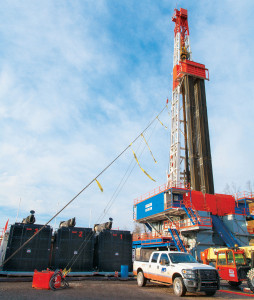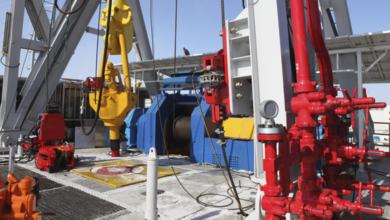Drilling & Completion Tech Digest
Natural gas engines replace diesel on drilling rigs

Antero Resources and Patterson-UTI recently finalized the installation of three rich-burn engines from Waukesha-Pearce Industries (WPI) that are 100% natural-gas fired. The Waukesha VHP L7044GSI engines aim to reduce fuel costs while also meeting state and federal mobile emissions guidelines.
“Reduced emissions and cost-saving solutions have been identified by Antero as a major area of opportunity,” Kevin Kilstrom, vice president of production for Antero Resources, said.
The first installation was implemented with a well completion in Harrison County, W. Va., and plans are in the works to replace diesel engines powering drilling rigs in multiple other locations.
“The L7044GSI can be easily exchanged with existing rig power-generation drivers, almost to the point that they’re ‘plug and play,’ as we’ve seen in this project,” Fred Stow, director of sales for WPI, said.
US EPA certifies Wärtsilä dual-fuel marine engines
Wärtsilä has obtained certification of emission standard compliance from the US Environmental Protection Agency (EPA) for its Wärtsilä 34DF dual-fuel engines.
“The Wärtsilä 34DF is the first dual-fuel engine fulfilling the EPA requirements,” Andrea Bochicchio, director, product management & engineering at Wärtsilä PowerTech, said. The Wärtsilä dual-fuel engine enables ships to operate on either conventional liquid marine fuels or LNG. The switch between fuels can be made seamlessly without loss of power or speed.

NCS places 50 stages in two-mile lateral wellbores
NCS Oilfield Services has placed 50 stages in a single well completion and demonstrated the reliability of its Multistage Unlimited system by repeating that feat in three consecutive wellbores.
“The application of our Multistage Unlimited system in two-mile laterals provides operators with the ability to access more of their reservoir with fewer wellbores,” Eric Schmelzl, NCS vice president of strategic business, said. “By successfully completing three consecutive two-mile laterals, we have demonstrated our ability to execute that style of completion without any extra tool trips, while maintaining an unobstructed wellbore.”
The multistage completions were all accomplished on two-mile lateral oil wells targeting the Bakken formation. The system combines a re-settable frac-isolation assembly deployed on coiled tubing with proprietary grip/shift sleeves.
Deep Casing Tools completes reaming system run in Oman
Deep Casing Tools has completed the first commercial run of a 5-in. total reaming system. The Turborunner successfully landed 14,764 ft (4,500 meters) of 4 1/2-in. liner in a vertical well in Oman, which included doglegs around a drilling fish. The system was activated and reamed the liner through the collapsed hole.
Petroleum Development Oman decided to run the system, which took 16 hours to complete, because of persistent wellbore problems. The system was used to ream the last 18 joints of liner.
BP invest in acoustic telemetry network for offshore wells
BP Ventures is investing in advanced acoustic telemetry technology developed by XACT Downhole Telemetry for drilling and completing difficult offshore wells. The technology provides high-speed, real-time data transmission in conditions where traditional technologies are limited or ineffective.
The network has been proven in more than 400 applications, Douglas Smith, an XACT director, said.
GOM project focuses on dry tree deepwater semis
DNV has been awarded a $3 million US Department of Energy-funded project to evaluate and support the development of two cost-competitive dry tree semisubmersible concepts, suitable for the Gulf of Mexico in a minimum of 8,000 ft (2,438 meters) water depth.
Evaluating projects developed by Houston Offshore Engineering and Kvaerner Field Development, DNV will act as a third party to evaluate the maturity level of each concept and define the further development scope based on critical design issues. DNV will perform an approval-in-principal for each concept and technology qualification for the riser tensioners.
“We are drawing on all of DNV’s international deepwater and technology knowledge and bringing it to Houston for the benefit of the local industry and development of floater concepts for the Gulf of Mexico,” Jenny Lu, who heads DNV’s involvement in the project, said.
The May/June issue of Drilling Contractor featured coverage of the 2013 OTC Spotlight on New Technology Awards. This article can be found in its entirety here.



